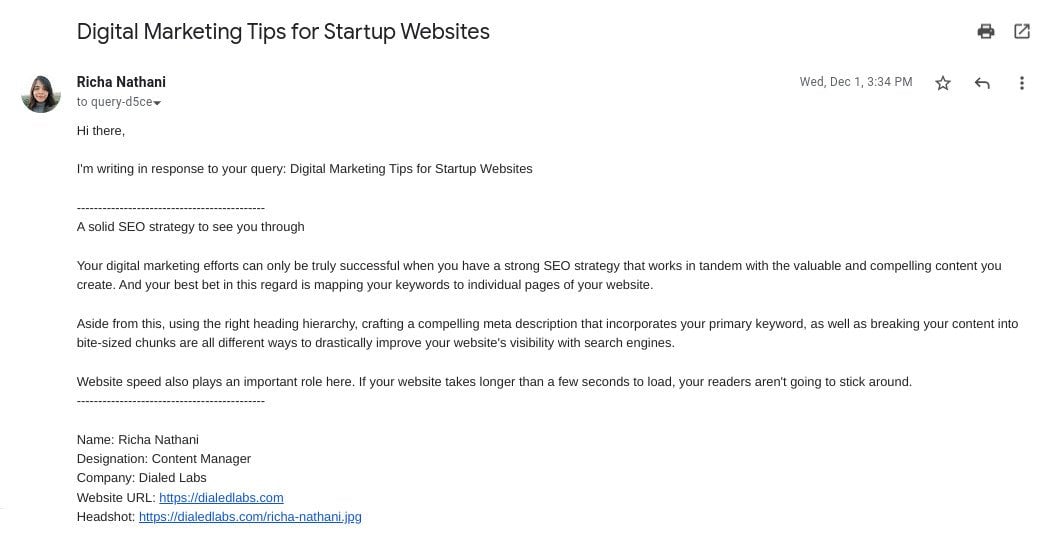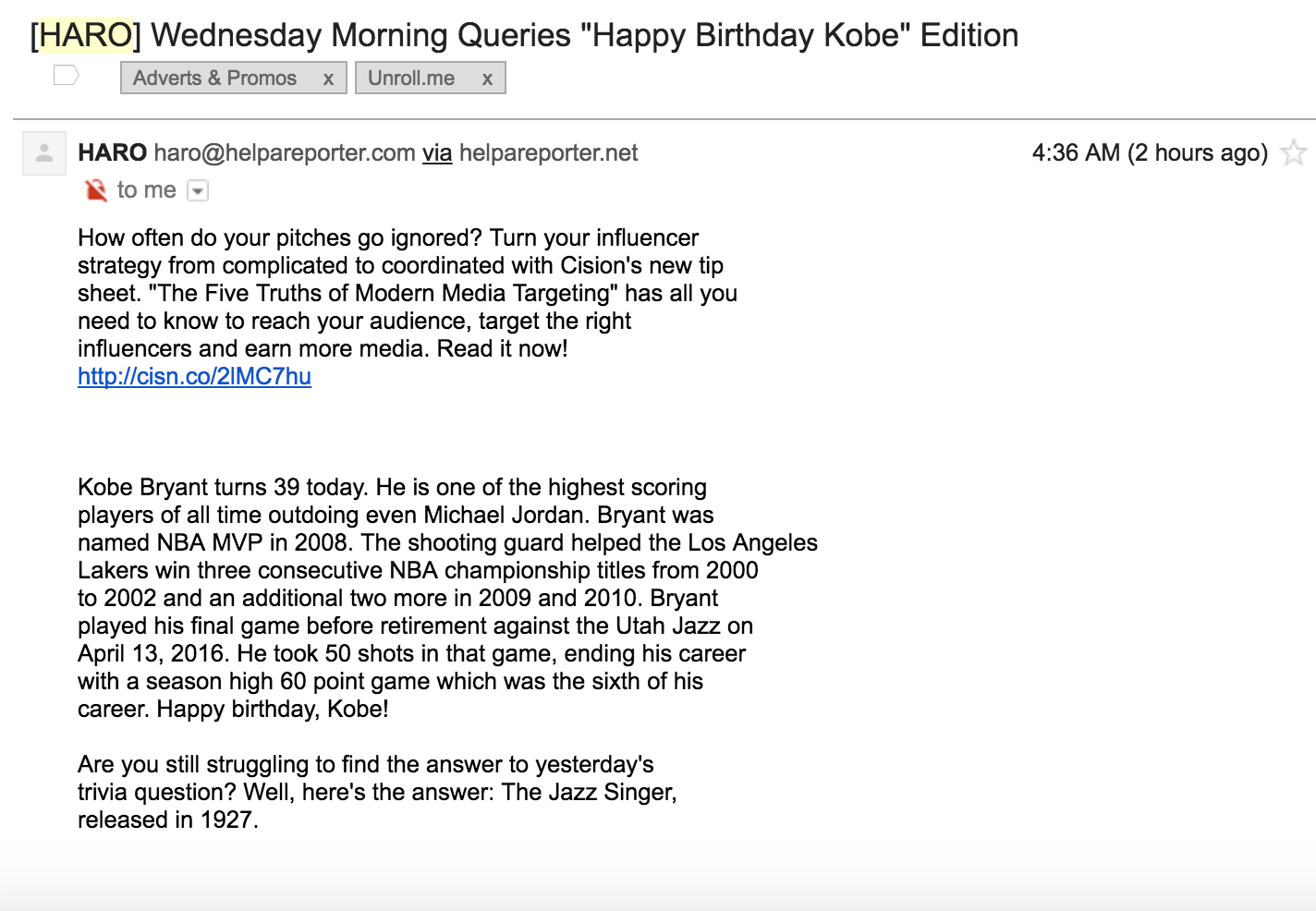Your PR guru might be a screen-tap away, but you are still inspo-stacking.
Most of the time, the PR releases or stories about a brand's success are not genuine. They either boast about the product too much or don't cite relevant sources.
If you publish a PR piece, be wary about the source and resources you mention. First, attribute the right person as a source. Second, revisit the roundup or coverage you have at hand. You cannot bring a news correspondent to quote CRM software. To know who is the best pick for you, register on HARO (Help a reporter out) and await your prestige pioneer to meet you.
Brand can also reach the masses if you create a digital news hub with online newsroom software as a part of your website marketing strategy. You can build your own landing pages and load them with personal decks, PR release resources, and case studies for the world to engage.
What is HARO (Help A Reporter Out?)
HARO, or Help A Reporter Out, is a PR marketing tool that helps reporters or journalists seek authentic information on any topic. It allows you to submit your concerns via email queries and wait till specific mentor circles back with an answer. It also arranges roundups, quotes, and links to your website that help boost social media traffic and PR network.
For anyone starting anew in PR and marketing, HARO is a search trotter. It helps crowdsource answers from familiar personalities to get extensive information on a topic. This widens the PR image, establishes brand awareness, and gives a bank shot in the media world.
A journalist or writer might put out a query, “Looking for ways that virtual reality is being used in small businesses.” Likewise, a small business (or its PR rep) using VR software can respond directly to the journalist, share its experience, and potentially be featured in an article.
While there are many uses for HARO, it boils down to two sides: writers and sources. And, as someone who has used it for both purposes, I can help you break it down.
How does HARO work for journalists and writers?
HARO is a platform to access answers to shared social media, marketing, and technology questions that people scrum about. Using HARO allows us not only to get a great diversity of answers but also to feature emerging voices that may otherwise not have the opportunity to contribute to the conversation.
It’s pretty simple for writers to use HARO. Make an account, post a query, and watch the responses roll in. From there, it’s up to you which you want to keep or toss.
Types of expert roundups you can get on HARO
Roundups are a collection of opinions, insights, and blockquotes contributed by subject matter experts to get insight into a topic. It is a great way to build linkable assets and rapport with peers and influencers.
- Content Roundup: Summarizes and links to hot content that your audience wants to read.
- Opinion Roundup: Charts an expert's opinion about a particular topic or service based on their experience.
- Expert panel Roundup: When the jury themselves answers the questions you submit to them, you get an expert panel roundup. This adds unique value to your content as it is unbiased, fair, and analytical.
Want to learn more about Public Relations (PR) Software? Explore Public Relations (PR) products.
Benefits of HARO for journalists
Journalists can get into what the experts think about through the HARO services. It keeps their pulse on what's trending in the market. At times, it also gets hectic to deal with a sea of HARO pitches as journalists. You can filter your Gmail based on specific HARO keywords and nitpick the best.
- Expert content: Journalists using HARO can reckon that they have acquired nothing but the best. The content has been pulverized in terms of quality, reliability, and accuracy. No other site features content as authentic as HARO.
- Expertise: HARO pitches are submitted by leaders with experience working for a particular domain the journalist is out and about. It means the content is verified, fact-based, and aligns with the requirements perfectly.
- Query pitches: To make that initial conversation-starting effort, the journalist must submit a query pitch to the expert. The pitch would have the request, name, category, media outlet, email (anonymity maintained for security purposes), and a deadline for the answer.
- Less work: A journalist does not have to initiate search trials. HARO connects you to the sources. A professional in that subject would asses your query and then reply on their own.
- Reliability: HARO maintains the highest performance and security standards and doesn't divulge implicit details about the source or the responder until they do not develop a good relationship. After that, the parties can engage in a personal conversation.
Example of a HARO pitch response
Subject matter experts are interested in crowdsourcing content, but they take a berth before replying. On their end, they follow the BNBR (be nice, be respectful) policy with the journalist and double-check whether the information they have shared is genuine.
 Source: SE ranking
Source: SE ranking
Let us look at another example of a PR source pitch:
Reece Stone <email ID>
Hi there
Subject: Surviving the wrath of the digital economy
Thanks for reaching out. I am writing in response to your query, "how to survive the wrath of the digital economy."
Every invention has its own pros and cons. In the wake of the great resignation, many employees have come clean on social media about technology replacing the workforce. However, on the same rope, you might have heard about the constant glee of ChatGPT.
While ChatGPT is automating hiring for businesses, the erroneous aspect of the application always gets a few laughs. We can't really keep a pulse on how the digital economy will turn out. It is a call of time. What we can do is decide whether the new innovations will take us for a ride or vice versa. We need to be grounded on the principles of humanity to tackle every challenge thrown at us. The sooner we will, the better we can dominate the digital economy.
Name: Reece Stone
Designation: Quality Analyst
Company: Accenture
Some popular HARO sources are listed in The New York Times, The Chicago Tribune, The Wall Street Journal, Time, and Thompson Reuters.
How does HARO work for sources?
HARO can be incredibly useful for sources as well. When I worked in public relations, I browsed the HARO email I got three times a day, looking for queries that would fit the wheelhouse of anything my clients could comment on. Sometimes the quality of the lead was unbelievable - we’d get placements in the Associated Press, Forbes, or Entrepreneur Magazine for an otherwise small brand that, really, no one was knocking the door down to get a quote from. True, sometimes it wouldn’t be a good fit, but it’s always worth sending a quick email if that means your client or brand can participate in a big story in a widely read publication.
Sources interested in HARO can sign up for the emails on the website, then respond to the query that interests you. You can receive queries from HARO three times at 5:35 a.m., 12:35 p.m., and 5:35 p.m. Eastern time). Juxtapose your experience with the query before typing in a reply. The reply can take the form of a pitch, where you offer the opportunity to exchange assets, links, and other resources and earn two-sided media coverage.
What good would it bring you to share your knowledge pearls with others? Let's see.
Benefits of HARO for sources
The sources, or the SMEs, always need to believe that "knowledge grows when it is shared." They should be willing to take a plunge into the debacle of many. If they gave out their learnings, they would get 2x benefit in return. Collaborating with fresh, jumpy journalists means reaching their audience and broadening your brand scope. Experts and sources can levy HARO for:
- Getting quoted: Getting the opportunity of being represented as a subject matter expert is a heartwarming opportunity. Through the PR reporter, they can get into the limelight, share their personal stories, and alleviate their personal brand.
- Link exchange: HARO provides a reliable exchange of linkable assets from reliable journalists. The practice generates outbound links faster than guest posting.
- Thought leadership: HARO allows you to open to cohorts for thought-provoking ideas. Commenting from the perspective of industry experts can position you as a top author. It is what every thought leader strives for, and HARO makes it seamless.

How to post a HARO query
It’s just a few easy steps to post a HARO query if you’re a journalist or writer looking to use the free service.
- Visit the HARO website and register as a journalist.
- Once your account is created and verified (check your email!), click "My Queries" at the top of the page.
- Then, click "Submit a Query" on the right side of the page.
- Fill out the request boxes and be as specific as possible. You can specify the word count, publication, company name, etc.
- When you're ready, hit submit - remember that HAROs go out three times a day - morning, afternoon, and evening. Try and think a few days ahead and give at least two or three days for responses to roll in unless you're in a time crunch.
Once you start getting responses, they'll be emailed to you by HARO. You can also access them on the HARO website by clicking "Past Queries" and scrolling down the page once you select the query.
HARO best practices
Being in a well-tucked contract with a journalist needs a foreword. You need to get on a call, lay down practices and guidelines, and make a rough scrape of how you want things to continue. There are a few ways to amplify your success with HARO.
1. Social media and web integration
When you create your HARO query, don’t forget to request social media handles from your sources. This includes Twitter handles for the writer and the brand, LinkedIn URLs, and the official website. Not only will your sources appreciate you throwing them a link in your final product, but you’ll also be able to give your article extra juice on social media when it runs. By tagging your sources, you’re almost guaranteed to lengthen your reach for social media marketing purposes.
Even if the post doesn’t expressly request it, go ahead and add your URLs and Twitter/LinkedIn handles to your post if you send it in as well - chances are, the writer will be grateful.
2. Relationship-building
You should have built a friendly, positive rapport with your sources by the time your article runs. If you’ve ever been on the other side of the writing/PR dichotomy, you know how frustrating it can be to spend time formulating a thoughtful response to a HARO or email, only to be left hanging with no idea if it was received.
In the interest of being a decent person, I like to send the sources I accept a brief note letting them know that I’ll be using their quote and thanking them for participating. Then, when the piece runs, I send them an email with a link and an idea of when I plan on sharing it on social media. These little touches help turn an easy request for info into a relationship - in many cases, I’m more than happy to work with sources again, either on a guest post or another contributor piece, if they’ve given me a good-quality response and quick communication.
3. Query evaluation
Take your time with each query. Do not answer out of the blue in Chinese. Learn where the user is trying to drive home, where they hail from, and what their requirements are. If you think that you are not best suited to give the answer, let it slide. Sometimes, being selective helps you to put yourself in the best shape.
4. Quick response
Journalists cover media stories, give monologues and inspect sites. With the earthquake aftermath in Turkey and Syria, they have been risking their lives to get you live coverage. Their time is precious, so take quick action. Do not wait for extra minutes to type in your response. Have an authentic tone without sounding eggy. If that is not feasible, you can still pitch within the published timeframe.
5. Editing and fine-tuning
Okay, maybe the editing part of the process can rest with the journalist. But as an established source, you must ensure your grammar and sentence structure are on point. Treat each pitch as if you are approaching an investor or are on Shark Tank. Try Hemingway editor, Grammarly, or other content editing tools to increase readability. Break down your sentences, relax your tone, and write confidently. Do not copy and paste.
6. Don't digress
Journalists are looking for "cream-of-the-crop" content. Do not disappoint them by giving out the same vague answers you do every time. Build analogies, and create storylines or narratives around a topic. Avoid fluff as much as possible because it can make your audience bounce off without warning. Be water-like, pester hard facts, and remain on-topic until the end. Off-limit pitches go against HARO practices and can result in a potential ban.
Make peace with hidden "paparazzi"
HARO might be a little intimidating, but it is a fun tool. It gives a weird angle to the traditional form of marketing but sits well with the young crowd. Get started with HARO and look out which next "PR move" is on your cards.
Be aware of where your brand might be taking you. Learn about brand awareness and how it keeps you packed in the marketplace.
This article was originally published in 2019. The content has been updated with new information.

Amy Lecza
Amy Lecza (she/her) is the former director of content marketing at G2. Her background is in journalism, PR, and content creation, and she has a degree in both journalism and culinary arts.
